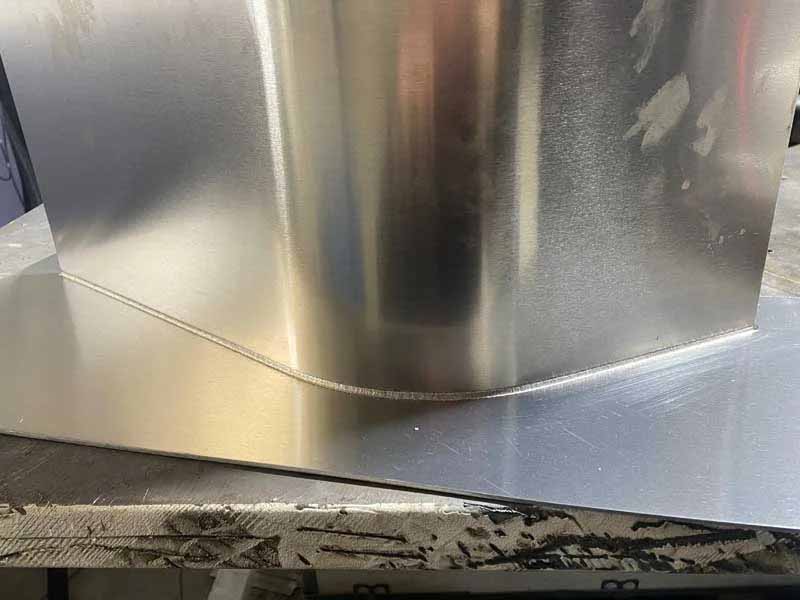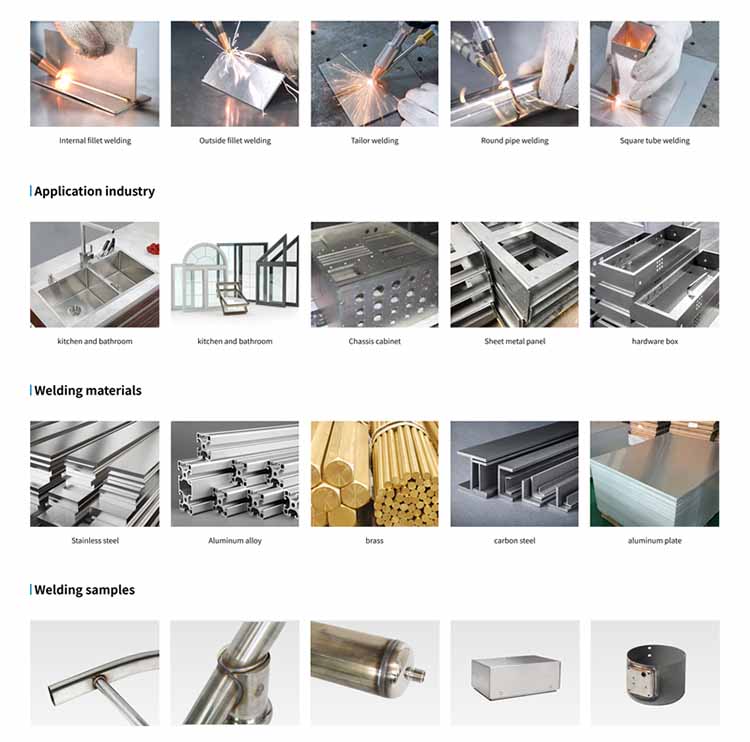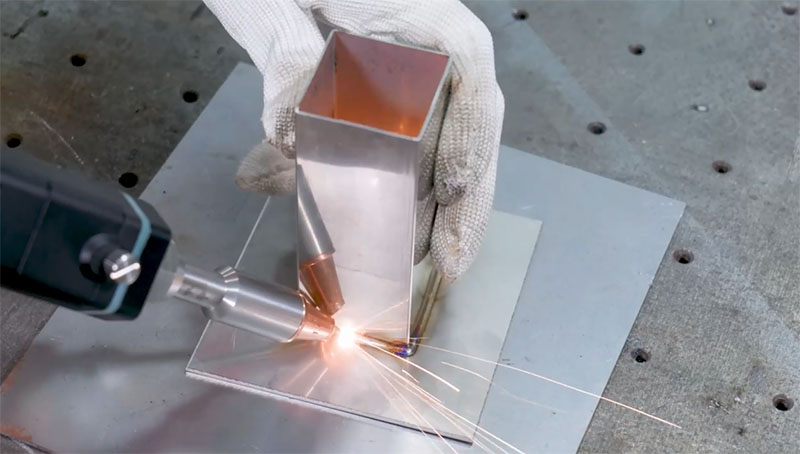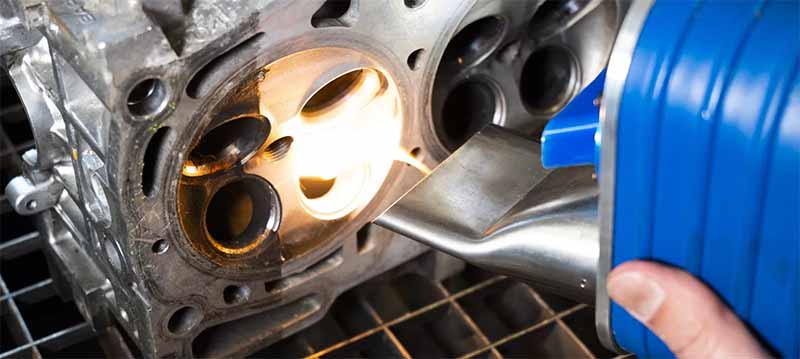Aluminum and aluminum alloys are widely used in industries such as construction and mechanical manufacturing due to their excellent strength-to-weight ratio and outstanding corrosion resistance. Fiber laser welding aluminum uses pulsed or continuous laser beams to heat the surface of aluminum alloys, rapidly increasing the surface temperature and conducting heat into the material, causing localized melting and forming a weld seam.
As an efficient and precise welding process, laser welding not only provides a reliable method for aluminum alloy processing but also ensures high-quality connections between aluminum components, enhancing the overall performance and quality of the final product.
Can You Weld Aluminum with a Laser Welder?
Absolutely. Aluminum and aluminum alloys are widely used in industries such as window and door construction, hardware tools, electronics, furniture appliances, and aerospace due to their lightweight, high strength, and excellent workability. For aluminum materials with thicknesses ranging from 1mm~10mm, laser welding provides a fast and cost-effective solution. This technology not only speeds up the welding process and reduces the need for manual operation, but it also allows for precise control of weld depth and width, ensuring that the weld seams are both aesthetically pleasing and structurally strong.
Advantages of Laser Aluminum Welding
Compared to traditional TIG/MIG welding processes, laser welding offers numerous advantages, making it the preferred method for aluminum welding in many industrial applications today.
Faster Welding Speed: Laser welding offers higher speeds and precision, often achieving a seamless weld in one pass, significantly enhancing production efficiency.
Lower Heat Input: The high energy density of laser welding allows for rapid heating and melting of the metal in a short time, minimizing heat effects on surrounding materials. This helps reduce thermal distortion and residual stress, especially beneficial for thin sheets prone to deformation.
Precise Control: By adjusting laser parameters, you can accurately control weld depth, width, and quality, producing more aesthetically pleasing and durable joints compared to traditional welding methods.
Non-contact Processing: Laser welding is a non-contact process, eliminating the need for direct electrode contact with the workpiece, which avoids electrode wear and reduces cleaning and maintenance costs.
Higher Weld Quality: Laser welding typically produces fine, smooth weld seams with minimal post-processing required, reducing the time spent on grinding and cleaning.
High Automation: Laser welding is easily automated and can be integrated with robotics for welding complex shapes, improving precision and consistency.
Strong Adaptability: Laser welding equipment can flexibly adjust the beam direction, making it possible to weld in hard-to-reach areas. Whether it’s thin or thick sheets, flat or curved surfaces, laser welding handles a variety of applications with ease.

Application of Laser Welding for Aluminum
Automotive Industry: Laser welding is critical in automotive manufacturing, especially in the production of car body structures. It is used to join body panels, creating lighter and stronger structural components, and is also applied in welding battery packs and other key parts of electric vehicles.
Aerospace Industry: With stringent requirements for weight and strength, laser welding is an ideal solution for manufacturing aircraft components. It is used to weld turbine blades, engine parts, and other high-reliability, precision-required components.
Electronics Manufacturing: In the electronics sector, laser welding is employed to handle small and complex parts, such as welding microelectronic components, fine joints on circuit boards, and casings of electronic devices.
Medical Device Manufacturing: Laser welding provides a clean, heat-affected-zone-free solution, making it perfect for producing high-precision medical instruments like surgical tools, implants, and diagnostic equipment.
Pipe and Hardware Manufacturing: Laser welding offers precise connections between different metal materials, making it suitable for producing pipes, containers, and various hardware products.
Home Building Materials Industry: From window and door production to lighting fixtures and kitchenware, laser welding offers strong and aesthetically pleasing welding solutions for the construction and home improvement sectors.
Mold and Machinery Manufacturing: For molds and machinery parts that require high hardness and wear resistance, laser welding provides an effective connection method.
Semiconductor Industry: As microelectronics continue to shrink, laser welding plays a vital role in semiconductor packaging and assembling sensors within microchips.

Challenges of Laser Welding Aluminum
- Common challenges in laser welding aluminum include porosity in the weld seam and deformation. Porosity is often related to the quality of surface preparation and welding parameters. Effective surface pre-treatment and optimized welding settings can significantly reduce the occurrence of porosity. To control weld deformation, proper adjustments to welding speed, laser power, and focal position are essential.
- Aluminum alloys, being non-ferrous metals, exhibit high reflectivity and low absorption of laser energy. Additionally, their strong thermal conductivity can cause rapid heat dissipation or laser reflection during welding, leading to potential weld failure. Therefore, when laser welding aluminum alloys, it’s crucial to swiftly increase laser power density to prevent heat from being reflected or conducted away.
- Aluminum alloys are reactive and prone to oxidation, with their surfaces often accumulating dust and moisture. These contaminants can become trapped on the surface during the fast welding process, affecting weld quality. Therefore, thorough cleaning of aluminum alloy surfaces, including the removal of oil and other residues, is necessary before welding to ensure optimal results.
How to Laser Weld Aluminum?
The process of laser welding aluminum relies on a high-energy-density laser beam that quickly heats the aluminum material to its melting point, allowing for precise welding. The laser welding of aluminum sheets or tubes can be divided into the following steps:
Pre-treatment: Clean, cut, and shape the aluminum sheet to ensure the surface quality and geometric precision.
Fixture: Secure the aluminum sheet in a specialized fixture and use a positioning system to align the sheets with the laser beam. Ensure proper gap control and alignment between the sheets.
Welding: Activate the laser source and protective gas, adjust the laser parameters and process conditions, and begin the welding process. Control laser power, welding speed, and focal position to ensure consistent weld quality.
Post-treatment: After welding, turn off the laser source and protective gas. Inspect the weld for quality and integrity, and perform any necessary post-processing, such as grinding, cleaning, or painting.

Laser Welding Aluminum Tips
- Surface Preparation: Before welding, clean the aluminum surface by removing the oxide layer and contaminants like oil and dirt. Mechanical grinding or chemical cleaning methods can be used to ensure a clean surface.
- Welding Parameter Settings: Adjust the laser welding machine’s parameters based on the aluminum sheet’s thickness, material, and welding requirements. Key settings include laser power, welding speed, and focal position to ensure consistent and high-quality welds.
- Use of Protective Gas: During the welding process, use protective gas to prevent oxidation of the aluminum surface. Common protective gases include argon and nitrogen.
Handheld Fiber Laser Welding Machine for Aluminum
The handheld fiber laser welding machine integrates a control system, laser source, gas management system, and safety features, making it ideal for spot welding medium to large workpieces, such as sheet metal, cabinets, enclosures, aluminum doors and windows, and stainless steel sinks. This welding method is particularly suitable for handling internal and external right angles and flat seams, offering advantages like a small heat-affected zone, minimal workpiece distortion, greater welding depth, and strong joints.
The laser power typically depends on the thickness of the aluminum and the welding requirements. Generally, aluminum welding requires higher laser power, typically ranging from 1000W~3000W. It is important to choose the appropriate model and power of the laser welding machine based on the specific welding project to ensure quality and effectiveness.

Welding Materials: Capable of welding various materials, including stainless steel, carbon steel, aluminum alloys, copper, and galvanized sheets.
Weld Forms: Able to achieve various welding forms such as butt joints, lap joints, corner joints, surfacing welds, groove welds, and fillet welds through laser welding.
Usage Environment: Suitable for indoor or outdoor welding operations, particularly for complex sheet metal and hardware components.
Laser Welding: Fast welding speed with minimal distortion, producing aesthetically pleasing welds that do not require post-welding grinding, thus saving labor costs.
Equipment Advantages: Simple operation and flexibility, requiring no specialized welding knowledge, allowing users to operate directly with ease.

Features of Aluminum Laser Welding Machine
High-Performance Laser Source: The Dapeng fiber laser welding machine is equipped with a high-quality laser source that provides exceptional beam quality, creating a small and focused spot for precise and efficient welding. Power options range from 1000W~3000W to accommodate various welding needs, ensuring high productivity without compromising welding quality.
Efficient Cooling Mechanism: To ensure equipment reliability and extend the laser source’s lifespan, our laser welding machine features an advanced water cooling system. This allows the machine to maintain stable performance and reliable welding results even during prolonged continuous operation.
Excellent Beam Quality: The machine offers excellent beam quality, generating a concentrated and precise laser beam suitable for welding various materials and thicknesses. This helps reduce welding spatter and minimizes the heat-affected zone.
Fiber Transmission: With flexible fiber cables as part of the beam delivery system, it easily integrates with automated production lines or robotic units, allowing the machine to adapt to different welding tasks, enhancing production line efficiency, and accommodating various manufacturing environments.
User-Friendly Interface: The intuitive operation interface enables users to take full control of the welding process. It allows for easy adjustments and settings of welding parameters such as power levels, pulse duration, welding speed, and focal position to achieve optimal welding results.
Comprehensive Safety Measures: The machine is equipped with extensive safety features, including protective covers, safety interlocks, and sensors, designed to protect operators from potential laser hazards, creating a safer working environment.
In conclusion, fiber laser welding machine presents advantages for aluminum welding, offering precision, speed, and strong welds. However, understanding the challenges like reflectivity and thermal conductivity is crucial for achieving the best results. By choosing the right aluminum laser welding machine, such as DPLASER 3 in 1 laser welding machine for aluminum, you can effectively overcome these challenges and ensure efficient, high-quality aluminum welding for your applications. Investing in the right technology will elevate your production capabilities and improve overall welding performance. Please contact us for your aluminum and aluminum alloy laser welding solutions.




